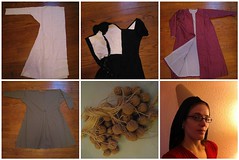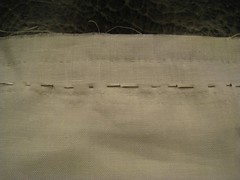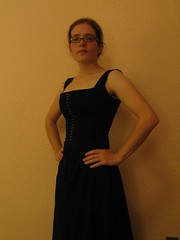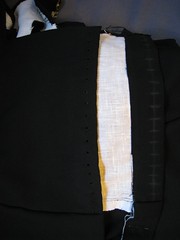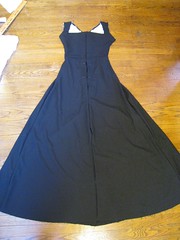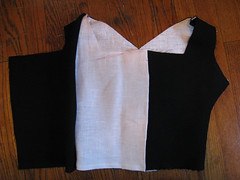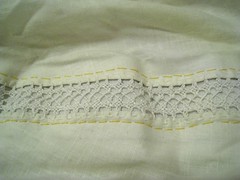Some people are posting wrap-up summaries of all the things they made this year. I figured I'd have more to talk about if instead, I covered all the things that are currently lying around in my sewing area.
Half a chemise. This is for the 1490s transitional gown project. Still needs: second sleeve attached, gores attached, neckline cut and finished, and hemmed.
Mostly done black kirtle. This is so close to done, and I've worn it already; I might wear it again this weekend and I should really remember to take pictures. Still needs: lining, and maybe replacements for those darn sleeves.
16th century Persian coat. This is luscious, I love the silk. Still needs to be hemmed, and buttons+button loop closures.
12th century wool tunic for my husband. I don't post about things for the man very often, since his style tends toward quite plain, but there it is. This still needs hand-finishing for points of gores, neckline, and hems. Plus I was debating adding contrast accents for the neckline and sleeves.
Enough fabric buttons for the sleeves of my Moy gown. I can't use these until I can manage buttonholes I don't hate...
And last but not least, a new hennin with bonnet. This is just a mock-up, started yesterday... for this weekend. Wish me luck!
And apparently, this is my 100th post. That's a nice way to round out the year :)
31 December 2013
09 December 2013
Non-sewing diversions
While the things I post here are mostly restricted to historic sewing, I am multi-crafty (in a ridiculous oh shiny sort of way). I took some enameling classes about six months ago, and I've been very taken with it. This is the latest piece that I have finished, and I wanted to share because I am inordinately proud of it.
05 December 2013
A rookie mistake
I'm working on a matching chemise for the black transitional kirtle - a pretty simple piece of untailored, geometric cut sewing. That didn't stop me from making a really brain-dead mistake.
I had made a mock-up based on measurements, sewed it quickly by machine, and everything was fine. Cut the real one to be hand sewn to the same measurements, starting sewing, and what do you know, the sleeves don't fit at all (too tight in the elbows). Because I had used french seams with very scant seam allowance on the machine sewn one, and had given a more generous allowance on hand sewing, to make turning the edges for false-french finishing easier. And that was the difference between a sleeve that lets me bend my elbow and one that doesn't.
So... move all the seams out that quarter-inch, and deal with very scant allowances for turning. And feel like you really ought to be past this sort of mistake.
I had made a mock-up based on measurements, sewed it quickly by machine, and everything was fine. Cut the real one to be hand sewn to the same measurements, starting sewing, and what do you know, the sleeves don't fit at all (too tight in the elbows). Because I had used french seams with very scant seam allowance on the machine sewn one, and had given a more generous allowance on hand sewing, to make turning the edges for false-french finishing easier. And that was the difference between a sleeve that lets me bend my elbow and one that doesn't.
So... move all the seams out that quarter-inch, and deal with very scant allowances for turning. And feel like you really ought to be past this sort of mistake.
20 November 2013
Transitional gown project progress
I got the black kirtle finished enough to wear last weekend, and I'm really happy with it. Of course, I completely forgot to get a picture of how it turned out. I had been hoping that one of our roving photographers caught me, but so far I've only managed to find myself in the background. So that's mostly done - hemmed and seams finished. The sleeves are still a bit funky, might rip them out and start over, and I remain undecided on whether to add a lining for the bodice. I've moved on to a chemise with a matching neckline, which should go relatively quickly.
In the meantime, here are some roughly contemporary portraits:
Portrait of a Lady with a Carnation, Master of the Legend of Saint Ursula
Portrait of a Donatrix, Lucas Cranach the Elder
Portrait of a Female Donor, Jan Provost
And of course Portrait of Margaret of Austria, Jean Hey (called Master of Moulins)
In the meantime, here are some roughly contemporary portraits:
Portrait of a Lady with a Carnation, Master of the Legend of Saint Ursula
Portrait of a Donatrix, Lucas Cranach the Elder
Portrait of a Female Donor, Jan Provost
And of course Portrait of Margaret of Austria, Jean Hey (called Master of Moulins)
Labels:
15th c.,
16th c.,
Continental early Tudor
22 October 2013
Kirtle progress - sleeves and little details
I've continued working on the black kirtle as I have time, although there aren't any dramatic (or particularly photogenic) changes. I put hooks and eyes in for the skirt portion of the front opening, with the two edges overlapped the same way they are for the lacing so there aren't any visible gaps. Last night, I drafted out short little sleeves for it (pictures/mini-tutorial: 1 2 3 4 5 6). Sleeveless would be an option as well, I think, but both cases would usually have separate pin-on long sleeves if being worn without an overgown, and the sleeves I make for my earlier dresses don't come up quite far enough to the shoulder. In the interest of being able to re-use pieces, this dress will have short sleeves too. Now it's on to all the seam finishing for the bodice seams before I set in the sleeves. After that, seam finishing in the skirt, hemming, and deciding whether to add a lining in the bodice.
Labels:
15th c.,
Continental early Tudor
10 October 2013
Perseverance has its rewards
I put in the last dozen or so eyelets on the kirtle today. I am so sick of eyelets, it was really a case of having to force myself to work on them. But they are all in now, and I could really try the dress on for the first time without pins or basting.
I think I'm in love. I am so much more motivated to keep working on this, because I want to wear this dress pretty much immediately.
I think I'm in love. I am so much more motivated to keep working on this, because I want to wear this dress pretty much immediately.
25 September 2013
Eyelets are slow work
The picture isn't great (black on black), but I'm halfway through the eyelets for the front closure on the kirtle. This feels like it is going to take forever...
05 September 2013
The finally-finished surcoat
I was able to hem this in the car on the way to an event. (Although it ended up being too warm to need or want it.)
It really is a simple garment. Rectangular body; gores for front, back, and sides; and scoops cut for the neck and arms. Easier than a tunic.
It really is a simple garment. Rectangular body; gores for front, back, and sides; and scoops cut for the neck and arms. Easier than a tunic.
Labels:
14th c.,
showcase,
sleeveless surcoat
30 August 2013
Kirtle in progress - skirts attached
Here's the state of progress on the kirtle. There are four flared skirt panels (instead of rectangular with gores). I think you could make an argument for either cutting layout, but it's ultimately a practical decision to minimize seams on a handsewn garment. The two back panels have more flare than the front panels, and there's a small reverse box pleat at center back to take up some extra width in the skirt panels and match the bodice back width. The fabrics drapes very nicely (swish swish :) ). Next up are eyelets and finishing the front opening.
Labels:
15th c.,
Continental early Tudor
14 August 2013
Transitional gown images from the British library
Progress continues on the kirtle, but there's not much to show. I've cut the skirts, and I'm working my way through those long seams.
Instead, here's some link-spam from the British Library. Unfortunately, the BL's viewer, while very good, appears to be a bit 'sticky', in that these direct links may try to load the manuscript you just viewed instead of the one that's actually specified. If you have trouble, head to the manuscript index page (also linked), load the viewer from there, and then select the folio as needed. In all cases, I've selected a few images of particular interest, and there are generally several other pages that feature the style.
The Breviary of Queen Isabella of Castile - begun in the Netherlands in the 1480s, portions later
f.3v, shows back of gown
f.417r, St. Martha, c. 1500 - square neck kirtle
Hours of Joanna I of Castile - produced in Flanders 1486-1506
f.5r, lady in gown and working woman in kirtle
f.6r, alternative gown with a skinny V-neck
f.26r, miniature of Joanna of Castile. She's got wider sleeves than I'd normally categorize as being this style (probably later, and/or a regional difference), and her headwear is in the French hood style.
f.288r, additional miniature of Joanna of Castile
'London Rothschild Hours' or the 'Hours of Joanna I of Castile - southern Netherlands, c. 1500
f.2v, lady in gown and working woman in kirtle
f.7r, working women, including V-back kirtle
Filippus Albericus, Tabula Cebetis, De mortis effectibus and other poems - France, Central (Paris); 1507
f.6v, allegorical depictions (and not the virtuous ones)
Instead, here's some link-spam from the British Library. Unfortunately, the BL's viewer, while very good, appears to be a bit 'sticky', in that these direct links may try to load the manuscript you just viewed instead of the one that's actually specified. If you have trouble, head to the manuscript index page (also linked), load the viewer from there, and then select the folio as needed. In all cases, I've selected a few images of particular interest, and there are generally several other pages that feature the style.
The Breviary of Queen Isabella of Castile - begun in the Netherlands in the 1480s, portions later
f.3v, shows back of gown
f.417r, St. Martha, c. 1500 - square neck kirtle
Hours of Joanna I of Castile - produced in Flanders 1486-1506
f.5r, lady in gown and working woman in kirtle
f.6r, alternative gown with a skinny V-neck
f.26r, miniature of Joanna of Castile. She's got wider sleeves than I'd normally categorize as being this style (probably later, and/or a regional difference), and her headwear is in the French hood style.
f.288r, additional miniature of Joanna of Castile
'London Rothschild Hours' or the 'Hours of Joanna I of Castile - southern Netherlands, c. 1500
f.2v, lady in gown and working woman in kirtle
f.7r, working women, including V-back kirtle
Filippus Albericus, Tabula Cebetis, De mortis effectibus and other poems - France, Central (Paris); 1507
f.6v, allegorical depictions (and not the virtuous ones)
02 August 2013
Kirtle bodice drafting and adjustments
For the kirtle bodice, I pulled the basic shape of the pieces from my existing 15th c. cote pattern. I cut them directly onto the linen canvas I'm using for interlining, and basted that together as a muslin. After tightening up the fit in a couple places (the cote pattern is cut a little generously), I sketched in the basic neckline shape (square in front, V in back), leaving it a little high to be cut down and finalized on the actual garment. Once I was happy with it, I pulled out the basting and transferred the design to be kept as a pattern for later.
With that done, I cut copies of the pieces out of the outer fabric and started assembly (handsewing with black silk thread). The only difference between the interlining and the outer fabric is that the interlining has a wider extension at center front, to be turned back with a double fold to support eyelets, while the outer fabric will have only a single fold. I've also chosen to put all selvedge edges at the waist seam, which should give a very sturdy edge for attaching the skirts.
The picture here is after I've sewn side, back and shoulder seams, and has the adjusted neckline drawn in on the front. The angle on the corners is significantly sharper than what I initially sketched. And although it looks like there's a rise at center front, in practice that is stretched down around my bust, and appears flat and level. (Presumably, ladies with smaller busts would need a less severe adjustment, if any.) The back neckline also needs to be cut down to a slightly sharper V (about an inch lower than here, which is already lower than the initial design).
With that done, I cut copies of the pieces out of the outer fabric and started assembly (handsewing with black silk thread). The only difference between the interlining and the outer fabric is that the interlining has a wider extension at center front, to be turned back with a double fold to support eyelets, while the outer fabric will have only a single fold. I've also chosen to put all selvedge edges at the waist seam, which should give a very sturdy edge for attaching the skirts.
The picture here is after I've sewn side, back and shoulder seams, and has the adjusted neckline drawn in on the front. The angle on the corners is significantly sharper than what I initially sketched. And although it looks like there's a rise at center front, in practice that is stretched down around my bust, and appears flat and level. (Presumably, ladies with smaller busts would need a less severe adjustment, if any.) The back neckline also needs to be cut down to a slightly sharper V (about an inch lower than here, which is already lower than the initial design).
23 July 2013
The Next Big Thing
It's been a while since I did a grand-scale dress project, and I've got the itch. I'm pretty excited about the next thing I'm going to be working on.
Here's the setting: 1490-1500 Flemish - contemporary to the Henry VII era in England. We've got square (or W) necklines, but still a natural, mostly unstiffened silhouette. Waistlines have dropped back down after the V-neck Burgundian gown. Sleeves are still closely fitted, but might have just a hint of a bell around the lower arm. Skirts are flat at the waist and flared to the hem, at least in the front, although there is some fullness starting to gather in the back. Hats have come back down to earth, with black lappets and veils, but are still simple compared to the gable headdress and French hoods that will come later.
Project plan: I'm starting with the middle layer, a kirtle. I've got medium-weight black worsted wool from Mood Fabrics. Bodice to be cut from my basic cote pattern, straight front with eyelets for lacing, linen canvas for some support, and it should just need a new neckline. It'll have short sleeves, and I just need to decide if I want plain gored skirt or some pleats in the back. The Tudor Tailor books mention wool lining for this layer, but I think that'll be intolerably warm for the settings where I'll be wearing this - probably a lightweight linen lining, and even then maybe only the bodice. The chemise should be pretty easy once I've got the neckline set on the kirtle. And for the outer gown I've got some lovely red wool in the stash. I might do wool with wool lining for the gown - currently leaning toward a white wool flannel or similar. Last up is headgear, I've already got suitable jewelry, and the deadline for the whole thing is next March. No problem, right?
Resources: The Tudor Tailor and Queen's Servants books are really good for this, despite being concentrated a bit later and a different country there are a lot of similarities. Amalia Zavattini has a good collection of material, especially the image bibliography, although the focus is a broader than what I'm going for here. Mary-Grace of Gatland also has some inspiration pictures.
Examples:
Guiron le Courtois, fol. 009r
Annals of Hainaut, fol. 028r
French:
Book of Hours, MS Douce 72, fol. 002v
Book of Hours, MS Douce 72, fol. 045r (David and Bathsheba)
Book of Hours, MS Douce 72, fol. 077f
Book of Hours, MS Rawl. liturg. e. 36, fol. 090v
Book of Hours, MS Buchanan e. 3, fol. 032v
Book of Hours, MS Buchanan e. 3, fol. 037r
Le roman de la rose, MS Douce 195, fol. 001r
Le roman de la rose, MS Douce 195, fol. 002r
Le roman de la rose, MS Douce 195, fol. 007r
English:
Founder's and benefactors' book of Tewkesbury abbey, MS Top. Glouc. d. 2, fol. 015r
... and that's just what I found in the Bodleian's digital collection; I'll be trawling some other collections later.
Here's the setting: 1490-1500 Flemish - contemporary to the Henry VII era in England. We've got square (or W) necklines, but still a natural, mostly unstiffened silhouette. Waistlines have dropped back down after the V-neck Burgundian gown. Sleeves are still closely fitted, but might have just a hint of a bell around the lower arm. Skirts are flat at the waist and flared to the hem, at least in the front, although there is some fullness starting to gather in the back. Hats have come back down to earth, with black lappets and veils, but are still simple compared to the gable headdress and French hoods that will come later.
Project plan: I'm starting with the middle layer, a kirtle. I've got medium-weight black worsted wool from Mood Fabrics. Bodice to be cut from my basic cote pattern, straight front with eyelets for lacing, linen canvas for some support, and it should just need a new neckline. It'll have short sleeves, and I just need to decide if I want plain gored skirt or some pleats in the back. The Tudor Tailor books mention wool lining for this layer, but I think that'll be intolerably warm for the settings where I'll be wearing this - probably a lightweight linen lining, and even then maybe only the bodice. The chemise should be pretty easy once I've got the neckline set on the kirtle. And for the outer gown I've got some lovely red wool in the stash. I might do wool with wool lining for the gown - currently leaning toward a white wool flannel or similar. Last up is headgear, I've already got suitable jewelry, and the deadline for the whole thing is next March. No problem, right?
Resources: The Tudor Tailor and Queen's Servants books are really good for this, despite being concentrated a bit later and a different country there are a lot of similarities. Amalia Zavattini has a good collection of material, especially the image bibliography, although the focus is a broader than what I'm going for here. Mary-Grace of Gatland also has some inspiration pictures.
Examples:
Guiron le Courtois, fol. 009r
Annals of Hainaut, fol. 028r
French:
Book of Hours, MS Douce 72, fol. 002v
Book of Hours, MS Douce 72, fol. 045r (David and Bathsheba)
Book of Hours, MS Douce 72, fol. 077f
Book of Hours, MS Rawl. liturg. e. 36, fol. 090v
Book of Hours, MS Buchanan e. 3, fol. 032v
Book of Hours, MS Buchanan e. 3, fol. 037r
Le roman de la rose, MS Douce 195, fol. 001r
Le roman de la rose, MS Douce 195, fol. 002r
Le roman de la rose, MS Douce 195, fol. 007r
English:
Founder's and benefactors' book of Tewkesbury abbey, MS Top. Glouc. d. 2, fol. 015r
... and that's just what I found in the Bodleian's digital collection; I'll be trawling some other collections later.
19 July 2013
When it ceases to be fun, it ceases to be
Although no one but me's keeping track, it's been four years since I started this surcoat. And it is still not finished, although it's way closer than it was this time a year ago.
So, what happened to this obviously ill-fated project?
This surcoat was always intended to be hand sewn. That's not a problem; I hand sew a lot of things. But for some reason, and I don't even remember why, I decided that I was going to sew this with the same threads that the fabric was woven from. Maybe I had trouble getting a decent color match, maybe I just wanted to try working with a wool thread, but I decided I would get my thread by unraveling small sections of the main fabric. I know that other people have done this successfully. But for this project, it was a Bad Plan. A Very Bad Plan.
You see, this is a very fine lightweight wool. And the singles from which it is woven are also very fine, too fine and too weak to sew with. So they had to be plied - roll the ends between your fingers to build twist (but not too much, or it will break), fold it in half on itself and allow it coil. This is a lot of work, and I'd be lucky to get an 8 inch length to sew with. Even then, it might snag, or break, or untwist while I was sewing. It should be easy to see how, before much progress at all was made, this project began to sit in the basket untouched for longer and longer periods of time.
Friends, when a project inspires such dread of working on it that you'd rather pretend it didn't exist, it is well past time for the project to change. And so I made a simple change: I started over with different thread. A plain cotton thread in a contrasting light grey color. It's still handsewn. It's still the same pattern. And I still have more frustration than love for the project (have I mentioned that the fabric frays extremely easily, even when you're not trying to unravel it?), but at least it's going to get done. Someday. Maybe even someday soon. And if I want to sew with wool thread, I'll find a commercial source for something that's made for that purpose.
So, what happened to this obviously ill-fated project?
This surcoat was always intended to be hand sewn. That's not a problem; I hand sew a lot of things. But for some reason, and I don't even remember why, I decided that I was going to sew this with the same threads that the fabric was woven from. Maybe I had trouble getting a decent color match, maybe I just wanted to try working with a wool thread, but I decided I would get my thread by unraveling small sections of the main fabric. I know that other people have done this successfully. But for this project, it was a Bad Plan. A Very Bad Plan.
You see, this is a very fine lightweight wool. And the singles from which it is woven are also very fine, too fine and too weak to sew with. So they had to be plied - roll the ends between your fingers to build twist (but not too much, or it will break), fold it in half on itself and allow it coil. This is a lot of work, and I'd be lucky to get an 8 inch length to sew with. Even then, it might snag, or break, or untwist while I was sewing. It should be easy to see how, before much progress at all was made, this project began to sit in the basket untouched for longer and longer periods of time.
Friends, when a project inspires such dread of working on it that you'd rather pretend it didn't exist, it is well past time for the project to change. And so I made a simple change: I started over with different thread. A plain cotton thread in a contrasting light grey color. It's still handsewn. It's still the same pattern. And I still have more frustration than love for the project (have I mentioned that the fabric frays extremely easily, even when you're not trying to unravel it?), but at least it's going to get done. Someday. Maybe even someday soon. And if I want to sew with wool thread, I'll find a commercial source for something that's made for that purpose.
26 June 2013
My Birgitta: interlacing diagram
This was a long time in the making - I know just enough Illustrator to really frustrate myself when something isn't working the way I want it to. Anyway: this is the interlacing pattern I used for my previously blogged Birgitta cap. This builds on the diagram presented in the MC&T article, but the end product is a little different.
29 May 2013
Quick, to the OR! Can this dress be saved?
The summer camping season is upon us! Which means it'd be nice to actually have a week's worth of medieval clothes. That don't involve trailing hems. Or coat-weight wool. Or any of the other lovely-yet-impractical things that I so enjoy. So it was time to dig through all the simpler stuff that hasn't been needed for a while (years, in my case), and see what still works and what doesn't.
Firmly in the "doesn't work" camp was a particolor cote in the late 14th to early 15th century style. It was not the first, but close to the first thing I made after joining the SCA, and definitely the first dress I made on this (drafted) pattern. It was never perfect, but it was serviceable. For instance, it's not lined or reinforced, even for the lacing, and so although it's in no danger of ripping out, it does pull and gap rather than laying flat. A bigger problem, though, was the shoulders. Blame archery, I guess, but my arms and shoulders are bigger than they used to be, and I basically couldn't move my arms forward with this dress the way it was.
I had saved enough scraps of both fabrics from this dress that I was pretty sure I could re-engineer the thing, so I set out on sleeve reconstruction surgery. This works better as a series of photos with commentary in the description:
The starting point: left, right
The existing fit problems: front, back
Re-cutting the armscye: start, middle, end, laid flat
Final shoulder seam adjustment: more angle
Replacement sleeve: test, pattern, front, back Or just look at the whole set here. I think this was a complete success, and I just have a few raw edges to finish now before it's completely done!
Firmly in the "doesn't work" camp was a particolor cote in the late 14th to early 15th century style. It was not the first, but close to the first thing I made after joining the SCA, and definitely the first dress I made on this (drafted) pattern. It was never perfect, but it was serviceable. For instance, it's not lined or reinforced, even for the lacing, and so although it's in no danger of ripping out, it does pull and gap rather than laying flat. A bigger problem, though, was the shoulders. Blame archery, I guess, but my arms and shoulders are bigger than they used to be, and I basically couldn't move my arms forward with this dress the way it was.
I had saved enough scraps of both fabrics from this dress that I was pretty sure I could re-engineer the thing, so I set out on sleeve reconstruction surgery. This works better as a series of photos with commentary in the description:
The starting point: left, right
The existing fit problems: front, back
Re-cutting the armscye: start, middle, end, laid flat
Final shoulder seam adjustment: more angle
Replacement sleeve: test, pattern, front, back Or just look at the whole set here. I think this was a complete success, and I just have a few raw edges to finish now before it's completely done!
07 May 2013
The end of the retinue bag project
Last year, I made bags to be used by the retinue for my local SCA royalty. I had enough material left over, though, that I went ahead and made an additional pair for the prince and princess as well.
I handed them over to the coordinator this past on the weekend, on the morning of Crown Tournament. Coincidentally, this was just hours before close friends (including someone I'd asked for advice on the project) were crowned as said prince and princess.
So all the exciting projects I thought I might have time to work on this year? Probably not. At the moment, I'm rushing to make some very basic additional clothes (geometric-cut tunics) for my husband and I before the summer camping season.
I handed them over to the coordinator this past on the weekend, on the morning of Crown Tournament. Coincidentally, this was just hours before close friends (including someone I'd asked for advice on the project) were crowned as said prince and princess.
So all the exciting projects I thought I might have time to work on this year? Probably not. At the moment, I'm rushing to make some very basic additional clothes (geometric-cut tunics) for my husband and I before the summer camping season.
10 April 2013
How to handle Pinterest?
Pinterest, love it or hate it, is becoming an increasingly large part of the idea-space for all sorts of things, including the sort of historic costuming and re-creation things I post here. I'm probably late to this party, but I have noticed that a significant fraction of my incoming traffic comes from there (well, less so here than on my photo archive over at Flickr). For the record, I neither love nor hate Pinterest - I'm just trying to sort out how best to make use of it.
Let's be clear: I have no problem with my stuff being pinned. There are reasons why I post my photos under Creative Commons license (CC BY-NC-ND specifically), and one of them is to allow people to use and share my work, with the major condition that it include proper attribution and linkback.
But there are a few things I'm struggling to figure out with Pinterest. One of the big ones is how to stay involved in the conversation about my work. If someone comments here, or at the photos, I get that feedback, and I can respond if I want to. If someone re-pins or comments on my photos on Pinterest, though, I may never notice. I don't see the traffic until someone actually clicks through, and my suspicion is that's actually a pretty small fraction of the activity. Do I continuously search Pinterest for myself to keep tabs on things (or automate that with Google alerts)? Would that even work (aside from the awkward vanity aspect)?
What about items that are pinned in ways that are potentially misleading? There's a dress of mine on a board that's nominally about a drastically different culture (different place, 400-500 years apart!) I'm not representing my work as being the style of that culture, but people who don't dig down might not know that. That's not even getting to the potential issue of things posted without attribution, and although I'm really hoping that's not a big issue, it's dark matter to me - if it's not attributed to me, I'll probably never see it. I get the impression, though, that users are getting a bit better about proper linking than they were in the early days of the site (wishful thinking?)
None of these things are really unique to Pinterest - they were all issues to consider before as well - but Pinterest has made it so much easier, so the volume is higher and it's harder to ignore. There's also the potential to leverage the site for additional exposure. I've considered preemptively pinning everything I post here, for example, on a blatant self-promotion board. Would that be in terribly poor form? Or just completely ineffective?
If there are any creators with input or suggestions about how to handle your work on Pinterest, I'd be interested to hear them.
Let's be clear: I have no problem with my stuff being pinned. There are reasons why I post my photos under Creative Commons license (CC BY-NC-ND specifically), and one of them is to allow people to use and share my work, with the major condition that it include proper attribution and linkback.
But there are a few things I'm struggling to figure out with Pinterest. One of the big ones is how to stay involved in the conversation about my work. If someone comments here, or at the photos, I get that feedback, and I can respond if I want to. If someone re-pins or comments on my photos on Pinterest, though, I may never notice. I don't see the traffic until someone actually clicks through, and my suspicion is that's actually a pretty small fraction of the activity. Do I continuously search Pinterest for myself to keep tabs on things (or automate that with Google alerts)? Would that even work (aside from the awkward vanity aspect)?
What about items that are pinned in ways that are potentially misleading? There's a dress of mine on a board that's nominally about a drastically different culture (different place, 400-500 years apart!) I'm not representing my work as being the style of that culture, but people who don't dig down might not know that. That's not even getting to the potential issue of things posted without attribution, and although I'm really hoping that's not a big issue, it's dark matter to me - if it's not attributed to me, I'll probably never see it. I get the impression, though, that users are getting a bit better about proper linking than they were in the early days of the site (wishful thinking?)
None of these things are really unique to Pinterest - they were all issues to consider before as well - but Pinterest has made it so much easier, so the volume is higher and it's harder to ignore. There's also the potential to leverage the site for additional exposure. I've considered preemptively pinning everything I post here, for example, on a blatant self-promotion board. Would that be in terribly poor form? Or just completely ineffective?
If there are any creators with input or suggestions about how to handle your work on Pinterest, I'd be interested to hear them.
07 April 2013
Birgitta cap - wrap up
I had planned to put up a diagram for my interlacing pattern before I showed what it looks like on, but I just haven't had time to sit down and do the technical drawing. So here you have it, what the cap looks like in practice.
As you can see, especially with the folds at the sides, it's a little bit too big. I made mine noticeably bigger than the original, and I think that ultimately the right size for me would be about halfway between the two. But I really love it anyway :)
I have so many things I want to start next, and not enough time for any of them...
As you can see, especially with the folds at the sides, it's a little bit too big. I made mine noticeably bigger than the original, and I think that ultimately the right size for me would be about halfway between the two. But I really love it anyway :)
I have so many things I want to start next, and not enough time for any of them...
28 March 2013
Birgitta cap - pleating and embroidery
My cap is done, and was very well received.
Here's a close-up of some of the finishing details: pleating the bottom edge into the band, and embroidery on the band.
For the pleating, I did it as gathers onto a short running stitch, and then pushed together almost as tightly as possible. I'd sewn about 3/4 of the band on the first edge ahead of time, and then pinned the pleats down to it, and easing a little bit of a curve at the front corner. The flat parts of the band were attached with running stitch, but I switched to backstitch over the pleats to make sure each fold was caught at least once, and ended up sewing that section a second time to flatten down the folds.
With one edge of the band attached, and folds pressed to mark where it would be turned over, I free-handed the embroidery as described in Dahl and Sturtewegan's article. It's very simple to do, and really makes the edge pop. I'm very glad I ultimately added it, since I'd been debating leaving it off.
Once all that was done, the band was turned under and finished with hidden slip stitch.
Here's a close-up of some of the finishing details: pleating the bottom edge into the band, and embroidery on the band.
For the pleating, I did it as gathers onto a short running stitch, and then pushed together almost as tightly as possible. I'd sewn about 3/4 of the band on the first edge ahead of time, and then pinned the pleats down to it, and easing a little bit of a curve at the front corner. The flat parts of the band were attached with running stitch, but I switched to backstitch over the pleats to make sure each fold was caught at least once, and ended up sewing that section a second time to flatten down the folds.
With one edge of the band attached, and folds pressed to mark where it would be turned over, I free-handed the embroidery as described in Dahl and Sturtewegan's article. It's very simple to do, and really makes the edge pop. I'm very glad I ultimately added it, since I'd been debating leaving it off.
Once all that was done, the band was turned under and finished with hidden slip stitch.
18 March 2013
Birgitta cap, race to the finish
I've gotten a lot done on my Birgitta cap since the last time I posted, but apparently I forgot to take photos of any of it? My deadline for finishing is in just a few days, though, so for now the time goes to getting it done and writing up documentation, with a final set of posts here to come later.
17 January 2013
Birgitta cap - working both sides toward the middle
I can't overstate how much easier it has been to work the looping threads with a more open base.
Right now, I've got the fourth looping thread almost finished (two along each fabric edge), and I'm trying to figure out exactly how I'm going to finish the middle.
For anyone working from the article in Medieval Clothing & Textiles 4 (Fig 6.15 on page 137), please note that there are some errors in the diagram. The first two drawings on the left have a different under/over pattern from the one at the bottom (which is correct). And as far as getting from the second one on the right to the last one, it might as well say "magic happens here". I'm not entirely convinced that the final diagram is even a possible pattern of continuous threads - I'll be making mine up as I go.
Right now, I've got the fourth looping thread almost finished (two along each fabric edge), and I'm trying to figure out exactly how I'm going to finish the middle.
For anyone working from the article in Medieval Clothing & Textiles 4 (Fig 6.15 on page 137), please note that there are some errors in the diagram. The first two drawings on the left have a different under/over pattern from the one at the bottom (which is correct). And as far as getting from the second one on the right to the last one, it might as well say "magic happens here". I'm not entirely convinced that the final diagram is even a possible pattern of continuous threads - I'll be making mine up as I go.
02 January 2013
A fresh start for the new year
On New Year's Day, I decided that I really did want a fresh start on my Birgitta cap. So I took scissors all the way up the back, and ripped it all out.
I made all the modifications that I'd been pondering - I measured out all the spacing on the backing cloth beforehand. I sewed the outer fabric to the backing cloth firmly and at close spacing, rather than basting. I waxed my thread. I worked out in both directions from the middle, so that I could use a thread long enough to reach end-to-end with some to spare. And so far, I am much more optimistic about the result.
Here's to a New Year, and not settling for something that makes you unhappy.
Subscribe to:
Posts (Atom)
